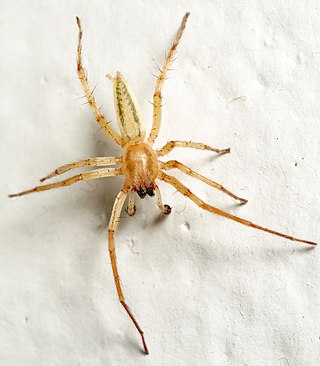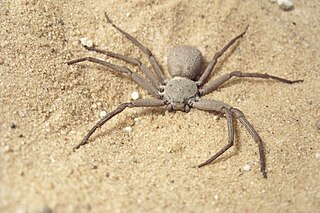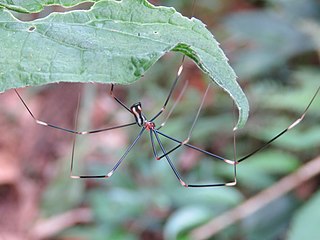
Anyphaenidae is a family of araneomorph spiders, sometimes called anyphaenid sac spiders or ghost spiders. They are distinguished from the sac spiders of the family Clubionidae and other spiders by having the abdominal spiracle placed one third to one half of the way anterior to the spinnerets toward the epigastric furrow on the underside of the abdomen. In most spiders the spiracle is just anterior to the spinnerets.

Oonopidae, also known as goblin spiders, is a family of spiders consisting of over 1,600 described species in about 113 genera worldwide, with total species diversity estimated at 2000 to 2500 species. The type genus of the family is OonopsKeyserling, 1835.

Wandering spiders (Ctenidae) are a family of spiders that includes the Brazilian wandering spiders. These spiders have a distinctive longitudinal groove on the top-rear of their oval carapace similar to those of the Amaurobiidae. They are highly defensive and venomous nocturnal hunters. Wandering spiders are known to hunt large prey, for example hylid species Dendropsophus branneri. Despite their notoriety for being dangerous, only a few members of Phoneutria have venom known to be hazardous to humans, but the venoms of this family are poorly known, so all larger ctenids should be treated with caution.

Sicarius is a genus of recluse spiders that is potentially medically significant to humans. It is one of three genera in its family, all venomous spiders known for a bite that can induce loxoscelism. They live in deserts and arid regions of the Neotropics, and females use a mixture of sand and silk when producing egg sacs. The name is Latin for assassin.

Goeldia is a genus of spiders that occur in Central to South America. It was first described by Keyserling in 1891. One species, Goeldia funesta, has been introduced to the United States.
Sanogasta is a genus of South American anyphaenid sac spiders first described by Cândido Firmino de Mello-Leitão in 1941.

Ariadna is a genus of tube-dwelling spider.
Pikelinia is a genus of South American crevice weavers that was first described by Cândido Firmino de Mello-Leitão in 1946.

Polybetes is a genus of South American huntsman spiders that was first described by Eugène Louis Simon in 1897. It is a senior synonym of Leptosparassus and Streptaedoea.
Otiothops is a genus of palp-footed spiders that was first described by W. S. MacLeay in 1839.

Mesabolivar is a genus of cellar spiders that was first described by M. A. González-Sponga in 1998.
Cinetomorpha is a genus of goblin spiders first described by Eugène Louis Simon in 1892. It is a senior synonym of Lucetia, and Yumates.







